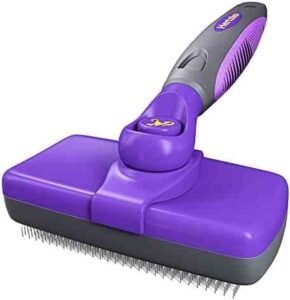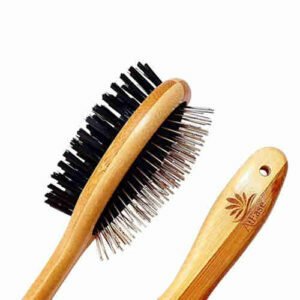The Maine Coon Neck Ruff Explained + 3 Ways to Brush

Most Maine coons sport a distinctive ruff around their necks. A common concern for new cat owners is whether or not their fluffy pet will develop a mane (or “neck ruff”).
Both male and female Maine coons, at around 9 months of age, will begin to develop the elegant fur around their neck and chest that will become very visible during the winter months.
We have covered all the bases in this article, from when to expect the maine coon neck ruff to why your cats might be slow to develop one and how to maintain it.
Read: Maine Coon Siamese Mix
Table of Contents
- What Is a Maine Coon Neck Ruff?
- Do All Maine Coons Have Neck Ruffs?
- Do Female Maine Coons Have Neck Ruff?
- Do Maine Coon Cats Shed Their Neck Ruff?
- How Does the Maine Coon Neck Ruff Benefit the Cat?
- How Do I Care for My Maine Coon’s Neck Ruff?
- What if My Maine Coon Doesn’t Have a Neck Ruff?
- When Do Maine Coon Kittens Get Their Neck Ruff?
- Do Maine Coons Shed?
- Should I Brush My Maine Coon Cats Neck Ruff?
- Conclusion
What Is a Maine Coon Neck Ruff?
My son refers to this cat breed as mini-lions(funny)— the neck ruff gives the maine coon the elegant lion-Esque looks. A neck ruff is the extensive growth of fur along the sides and the top of the neck.
A neck ruff is a feature that’s unique to the Maine Coon breed of cat. It’s a long, fluffy fur collar that runs from the cat’s chin to the chest.
Some Maine Coons have a very pronounced ruff, while others have a more subtle version. But all Maine Coons have some degree of ruff fur, which will start becoming more visible from 9 months old.
The neck ruff is an essential feature for this breed because it helps keep them warm in cold climates. It also acts as a kind of scarf, helping to protect the cat’s neck from the cold winter weather.
Do All Maine Coons Have Neck Ruffs?
The male Maine coons indeed have neck ruff, but the absence of a mane in a female maine coon over nine months may trigger you to ask: do female maine coons have manes? Yes, they have manes that start becoming more pronounced from 9 months on; if your maine coon neck ruff doesn’t show up, then you should know you’ve got a mix.
The maine coon neck ruff is a significant trait of this beautiful giant cat breed. This genetic trait is passed down from generation to generation, and it’s something that sets Maine Coons apart from other species. The neck ruff is a sign of strength and good health, and it’s also super soft and cuddly.
If you’re lucky enough to have a Maine Coon with a neck ruff, ensure you take good care of it. Groom it regularly and keep it free of tangles—since some persons may get unlucky and get a mix that will never grow a neck ruff.
Do Female Maine Coons Have Neck Ruff?
The female Maine coon is generally smaller than the male but physically larger than most other cat breeds. The maine coon cat is a breed that is not just loved in America; it is loved in most countries worldwide.
Female maine coins have neck ruffs that blends with their affectionate and laid-back personality. These neck ruff will become visible from the sixth month of the cat’s life. While in some cases, your female feline friend may not have a neck ruff until she turns 4.
Do Maine Coon Cats Shed Their Neck Ruff?
The luxurious maine coon neck ruff will never vanish completely. However, if you habit tropical regions, you will notice periodical changes in the fullness of the mane.
The maine coon neck ruff is shed more when hotter weather approaches. During this, the maine becomes less prominent and thinner—making your cat have a lighter summer coat. This will help your pet stay cooler when the scorching temperatures kick in.
As the summer fades away along with the hazy side+walks, 100-degree days, and sticky skins, the fall helps we humans to settle in the incredible romance of nature; our fury friends will also partake in the love of the fall, and they will have a significant increase in their neck ruff—this increase will aid the cat in keeping warm during the fall. The maine coon neck ruff will become fuller in all its glory
How Does the Maine Coon Neck Ruff Benefit the Cat?
Just like the evolution theory will state: Evolution is the process of change in all forms of life over generations. Just as the ostrich developed longer legs over the years—to aid it in running faster. The maine coon neck ruff grew to serve as a survival tool. The mane makes the cat breed look bigger than it appears—helping to deter predators.
When maine coons were brought to America, the harsh winter weather forced them to adapt to their environment by developing more notable neck ruff. The fact that your mine coon shed heavily during warner weather — backs this theory. The primary benefit of the maine coon neck ruff is to keep your cat warm in extreme winter weather and cool in scorching summer weather.
How Do I Care for My Maine Coon’s Neck Ruff?
First, it’s essential to keep the neck Ruff clean and groomed. You can do this by using a soft-bristled brush to remove any dirt or debris gently. Don’t forget to check the ears and the rest of the body, too, as they can also get dirty quickly.
Make sure your cat has plenty of fresh water and food, and try to bathe them once a month. (Be sure to use a mild shampoo for cats.) And finally, don’t forget to share with your kitty lots of love and affection!
What if My Maine Coon Doesn’t Have a Neck Ruff?
All adult maine coon have neck riffs, but if your pet is an exception, there is nothing to worry about; the absence of neck ruff doesn’t make the cat any less of a maine coon.
However, the and en of a neck ruff on a maine coon can happen(rarely), but the breeder’s practices usually cause it. Some breeders will mix the maine coon with other breeds, resulting in an inability to grow a neck ruff.
Show your cat all the love you should create fun memories, and if you ever feel your cat is cold, you can use a scarf and warm her up.
When Do Maine Coon Kittens Get Their Neck Ruff?
Like the full coat and teeth, it takes time for the maine coon neck ruff to develop fully. As a kitten, your maine coin neck ruff would not be so noticeable or plush as you would have wanted it to be. In general, this cat breed grows slowly—requiring 3- 5 years to hit full maturity. So at what age do maine coon neck ruff grow?
The elegant neck ruff will not become so visible until your maine coon is nine months old—it could even take your cat up to 4 years before the neck ruff becomes full. Therefore, you should have more patience, and everything will fall in place literally.
The neck ruff begins to grow slowly but steadily; if your cat fails to develop a full mane— then it’s likely to be a part maine coon and not a pure breed, or it’s still too young.
This is the painful part: not all pure-bred maine coon will grow a maine, so the neck ruff shouldn’t be a pointer—in determining if the cat is a pure breed.
Do Maine Coons Shed?
Yes, Maine Coon cats do shed. Here are some details about their shedding pattern and related care:
- Seasonal Shedding: Maine Coons have a long, thick double coat that helps them cope with cold weather. This means they tend to shed seasonally, typically in the spring and fall, to prepare for the changing temperatures.
- Regular Grooming: Due to their long and dense fur, Maine Coons benefit from regular grooming. Brushing them at least a couple of times a week can help reduce the amount of loose hair and prevent mats and tangles. This is particularly important for the areas behind the ears, under the legs, and around the neck.
- Less Shedding than Some Breeds: While Maine Coons do shed, they might not shed as much as some other long-haired breeds. However, the amount of shedding can vary from one individual cat to another.
- Diet and Health: A balanced diet can help maintain a healthy coat and potentially reduce shedding. If you notice excessive shedding or bald patches, it might be a sign of a health problem, and you should consult a veterinarian.
- Bathing: While Maine Coons are known to enjoy water more than some other cat breeds, frequent baths aren’t necessary. However, an occasional bath can help remove loose fur and reduce shedding for a short period.
In summary, while Maine Coons do shed, regular grooming and proper care can help manage the amount of loose fur.
Should I Brush My Maine Coon Cats Neck Ruff?
You might be wondering, should I brush my Maine Coon cats mane? And the answer is yes, you should!
In the wild, a Maine Coon’s collar would help protect it from predators. But since your cat is safe and sound indoors, you can help keep its neck ruff clean and tangle-free by brushing it regularly.
Be sure to use a soft-bristled brush, and brush in the direction of the hair growth. This will help prevent mats and tangles and keep your cat looking its best.
Brushing your maine coon neck ruff and grooming, generally, should be done two times weekly. Grooming your cat is a way of bonding and preventing your cat from undergoing psychological distress that may arise from matted hairs. Be sure that; grooming is time intensive.
Three best brush To Use for a maine coon neck ruff and coat
The neck ruff and the maine coon’s fur gets matted quickly—this will occur more frequently in the winter months. No single brush can be used for the entire grooming regimen; this is why we are providing you with different brushes and their respective uses.
1. Hertzko Self Cleaning Brush

This brush is effective for removing matt from your pet’s fur.
2. AtEase Dual-Sided Pin Brush

This double-sided brush has muti-functionality. This brush dematts and desheds your main coon fur; its soft pins ensure natural oil is spread evenly—it also stimulates blood flow.
3. Grooming Glove for Maine Coon Neck Ruff
This glove is everything fun; our case loves hand strokes and rubs on their head, belly, and entire body. This brush’s beauty is that; you can easily groom your cat while you stroke them. These gloves are soft and gentle
Conclusion
A Maine coon’s neck ruff, while ornamental, is not just for show. This extra layer of fur helps protect the neck and chest from the cold and wind.
So the next time you’re admiring your Maine coon’s lovely neck ruff, know that it’s more than just a pretty accessory—it’s a functional part of their anatomy that helps keep them warm and comfortable




